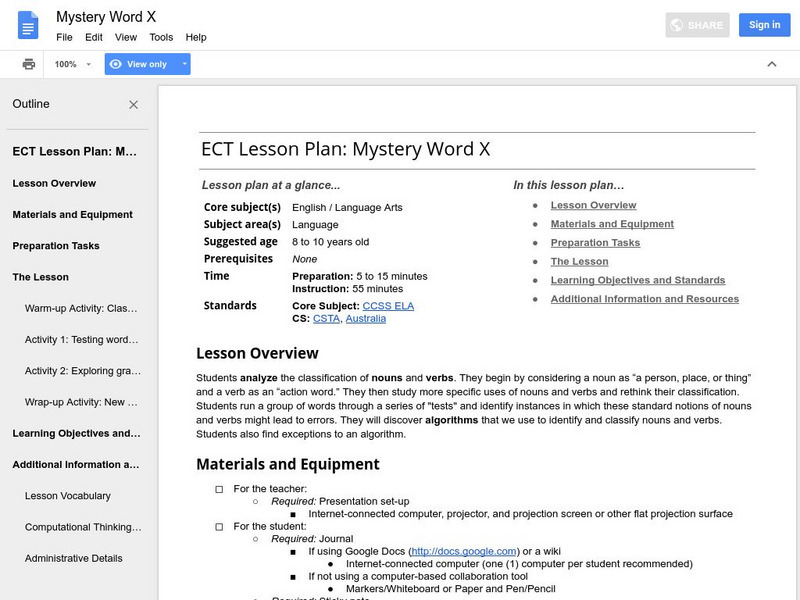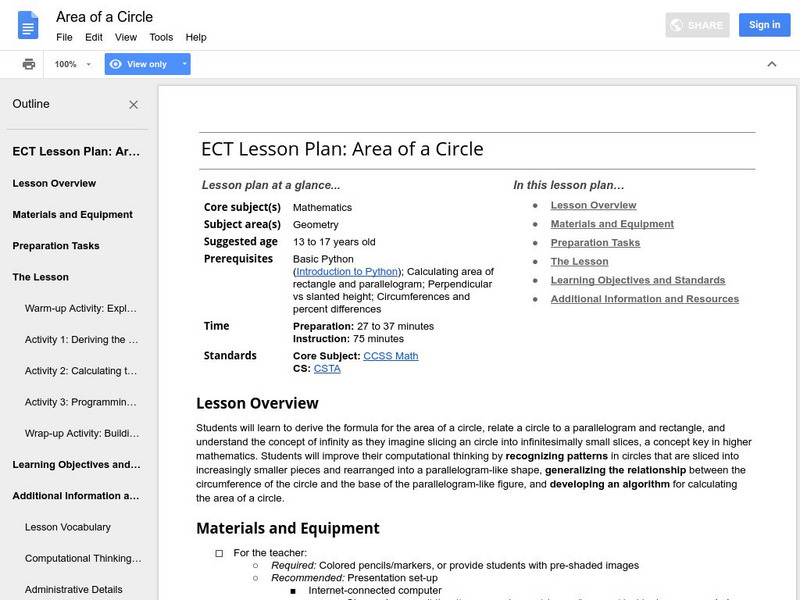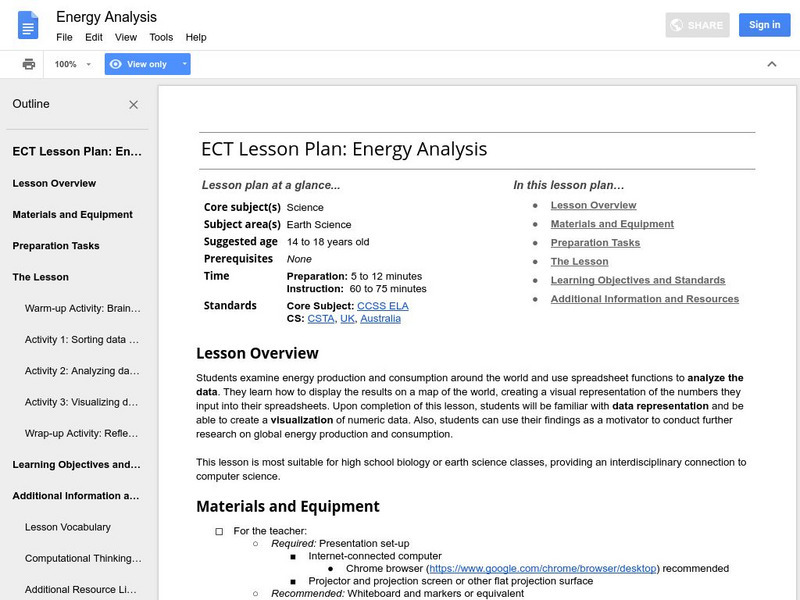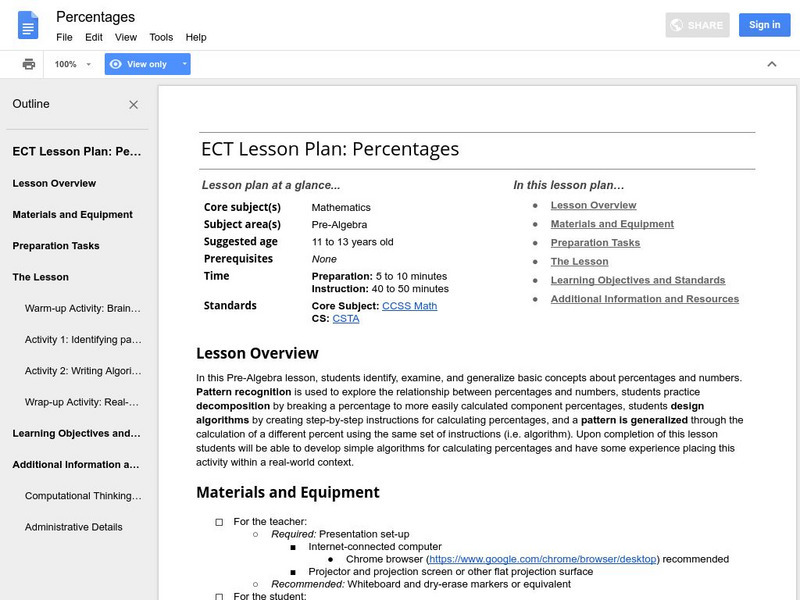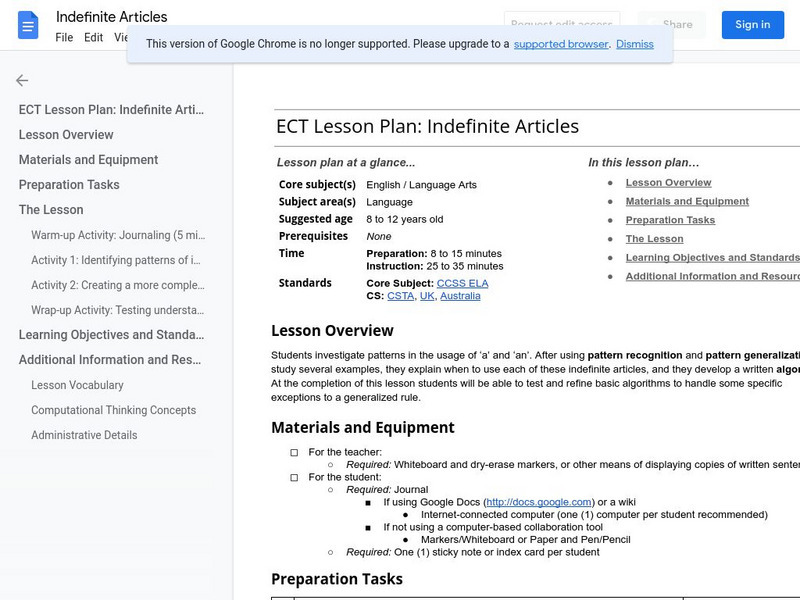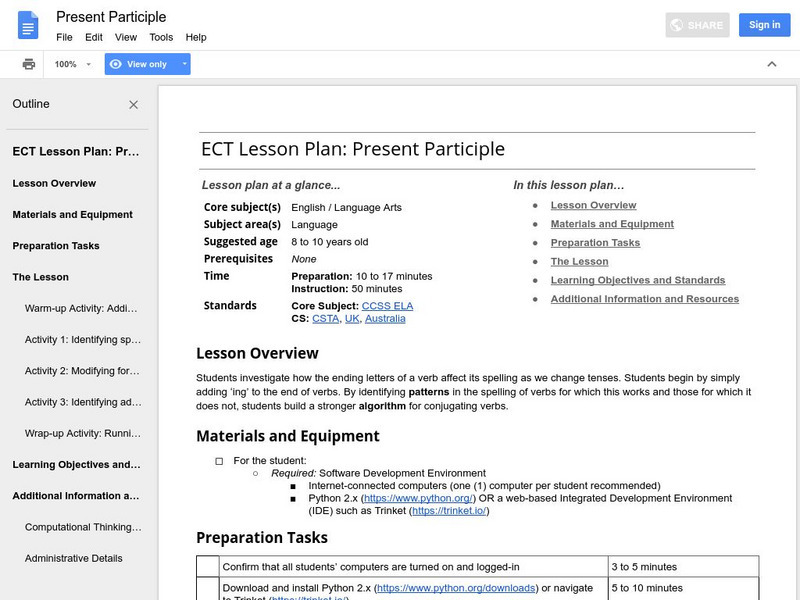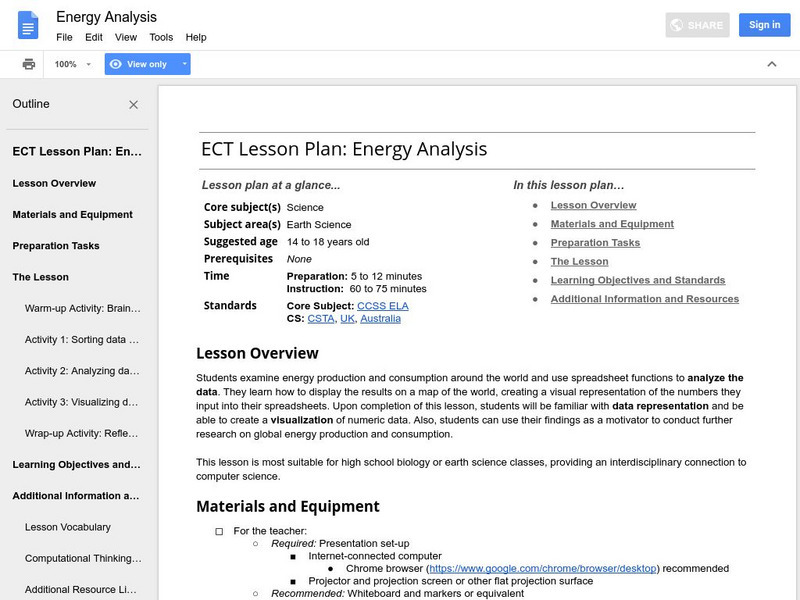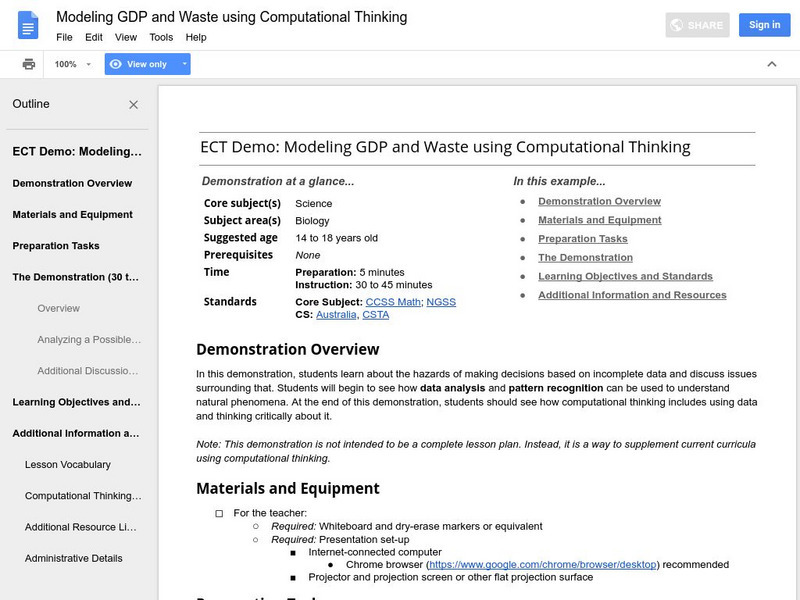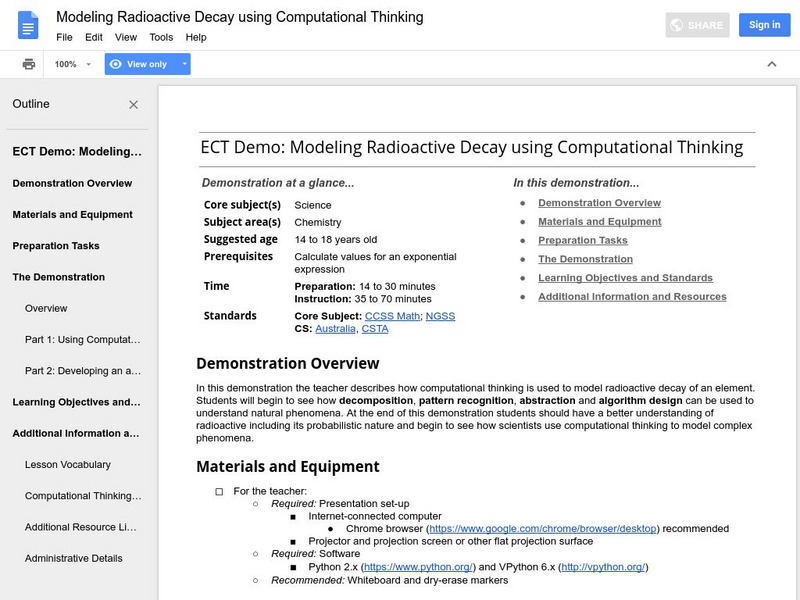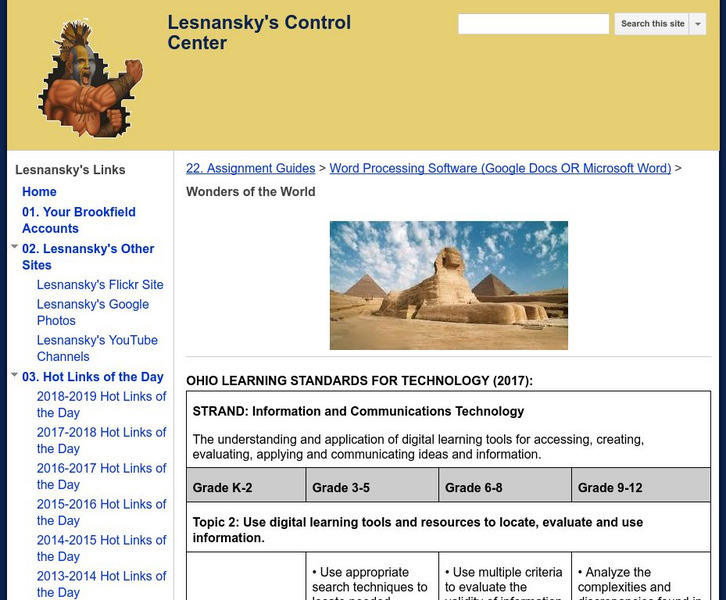Hi, what do you want to do?
Google
Google for Education: Mystery Word X
An exercise for students to analyze the classification of nouns and verbs. They begin by considering nouns as a person, place, or thing, and verbs as action words. Students then study more specific uses of nouns and verbs and rethink...
Google
Google for Education: Area of a Circle
Students learn to derive the formula for the area of a circle. They learn to relate a circle to a parallelogram and rectangle while learning the concept of infinity as they imagine slicing an circle into infinitesimally small slices.
Google
Google for Education: Energy Analysis
Students collect data on energy production and consumption around the world. They input the data into a spreadsheet and use spreadsheet functions to analyze it. Finally, they upload the data into a fusion table to create a visualization.
Google
Google for Education: Example: Patterns in the Periodic Table
A lesson plan where students examine the trends in the periodic table.
Google
Google for Education: Percentages
This activity asks students how to quickly and accurately calculate percent problems in our heads.
Google
Google for Education: Indefinite Articles
Students identify a pattern in the usage of the articles 'a' and 'an' and then write an algorithm that others can follow to correctly use these two indefinite pronouns, and they identify possible exceptions the general rule.
Google
Google for Education: Present Participle
In this example students learn two special cases for the past and present participle of verbs. They reinforce their understanding by completing a Python program to correctly conjugate special cases of verbs.
Google
Google for Education: Energy Analysis
By creating a spreadsheet, students can learn more about energy production and consumption around the world. Students have to research the data to be analyzed in the spreadsheet. An example of the spreadsheet is given in this lesson plan.
Google
Google for Education: Life on Minimum Wage
A game where students try to reach financial goals by working and budgeting their money. Site includes rules for games as well as playing pieces.
Google
Google for Education: Modeling Pendulums Using Computational Thinking
In this demonstration, students learn how to use computational thinking to discover the laws which govern a pendulum's swing.
Google
Google for Education: Modeling Gdp and Waste Using Computational Thinking
A lesson plan showing how computer programming can be used to model biological principles.
Google
Google for Education: Model Radioactive Decay Using Computational Thinking
Through this demonstration students will understand radioactive including its probabilistic nature and begin to see how scientists use computational thinking to model complex phenomena.
Alabama Learning Exchange
Alex: Multimedia Careers
Students may be surprised that Computer Careers aren't all found under "Computer" in the Occupation Handbook. Students will conduct guided research of careers related to Multimedia Design and/or Multimedia Publication course objectives....
John F. Kennedy Center
The Kennedy Center: Art Lesson Plans, 9 12
Browse this selection of lesson plans for the visual arts classroom. Easy-to-use tools help you search for the kinds of plans that interest you most. Lessons are laid out in full, with supplies lists, instructional plans, assessments,...
Other
The Habitable Planet Simulation
This activity is designed to accompany an interactive on the Annenberg Learner website. Students investigate the changes that take place in an ecosystem when they alter the organisms in a food web. As they work with the simulation, they...
Khan Academy
Khan Academy: Collaborative Software
Find out how some apps and programs allow for real-time or asynchronous collaboration.
Other
Lesnansky's Control Center: Word Processing Software: Wonders of the World
In this lesson, students watch a video about the Wonders of the World then research one of the Wonders and create a Microsoft Word document that details the story.
Other
Brookfield High School: Lesnansky's Control Center: My Favorite Movies
The student will complete exercises using Microsoft Word that are designed to showcase the different commands and the components of the various ribbons. Includes examples with explanatory captions.
Other
Lesnansky's Control Center: Word Processing Software: Time Traveler
For this activity, learners will create a word processing document that tells the story of where they would go and whom they would like to meet if they could time-travel.
Purdue University
Purdue University: A Basic Overview of Aquaculture [Pdf]
A vocational discussion of aquaculture that includes a history of the field, its environmental impact, use of water, and the like. (Published in 1900.)
Other
21 Things4 Students: Advantages and Disadvantages of Different Media Table
This chart lists different tools students can use to create digital media. The table covers animation, audio recording and podcasts, cartoons, infographics, interactives, screencasts, slideshows, and videos. Each tool has a list of...
Other
Uss Constitution Museum: Room to Set Sail
This is a USS Constitution Museum resource that has young scholars compare the area of the size of the sails of the USS Constitution as it compares to their classroom.
Other
Uss Constitution Museum: Constitution Collage
Tell the class that they will be making collages of USS Constitution. Reproduce the sails and hull pages to hand out along with scissors, rulers, paste and pieces of paper 11" x 17" on which students may assemble their collages.
Other
Uss Constitution Museum: Design a Figurehead
This USS Constitution Museum resource is a lesson plan that calls for students to work together in teams to create a new figurehead for the USS Constitution that was destroyed while on patrol.





